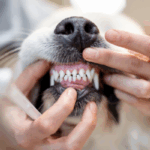Statistics show that obesity affects 25 to 44% of dogs, and 6 to 12 % of cats.
 What causes obesity?
What causes obesity?
There are some medical conditions that can cause obesity, however these are uncommon (Diabetes, Hypothyroidism, Cushing’s disease, any cause of abdominal distension).
Some individuals may have a slower metabolic rate than others & tend to put on weight very easily. Certain breeds of dogs seem to have a genetic pre-disposition for obesity e.g. Labrador retrievers.
However, the main causes of obesity are excessive food intake & low activity levels.
Overeating situations can occur due to boredom or emotional stress. In multi-animal households the fastest eaters may consume more than their share of food. Sometimes we inadvertently condition our dogs to overeat by indulging them with the wrong types of food or giving them constant treats throughout the day. Your dog’s requests may be for more attention, not more food.
Remember your pet can only overeat if you supply the food.
Why is obesity bad for my pet?
Being overweight or obese makes your dog susceptible to many problems including:
– Early onset of arthritis.
– Risk of musculoskeletal injury e.g. anterior cruciate ligament rupture
– Diabetes mellitus
– Increased risk of anaesthetic & surgical complications
– Reduced mobility, poor exercise tolerance, and decreased quality of life
– Hypertension (high blood pressure)
– Heat intolerance
– Breathing difficulties
There are 2 steps to successful weight loss:
1. Reducing the number of calories your pet eats.
2. Increasing the amount of exercise your dog does each day.
Make sure your dog has been examined by one of our vets to ensure there are no underlying diseases present & to select a reasonable target weight.
An appropriate weight-loss program will be devised for your dog. This may involve special low-calorie diet foods that allow feeding of “normal” quantities of food so that your dog is not hungry. We recommend regular “weigh-ins” at the clinic every 2-3 weeks. Our nursing staff will help you monitor your progress & advise any adjustments that may be necessary.
How important is exercise?
Regular exercise has many benefits:
– Raises the dog’s daily energy expenditure
– Increases the resting metabolic rate so that more calories are used throughout the day
– Reduces appetite
– Improves muscle mass & strength whilst burning fat
 What type of exercise, and how much?
What type of exercise, and how much?
An exercise program should begin at a low level & gradually build up. There are different levels at which you can exercise your dog:
Slow: Walking your dog on a leash
Moderate: Playing fetch, or off lead playing in the park
Rapid: Running or swimming
The amount of exercise recommended will depend on your dog’s age, health, condition & current activity level. You need to choose an exercise program for your dog that you will have the time & the ability to carry out.
e.g. for an older, unfit dog leash walking is probably best. Start with 10 minutes per day & increase daily sessions by 5-10 minutes each week until your dog is walking 60 minutes per day.
A younger healthy dog will benefit from leash walking and also more vigorous exercise.
Remember, start your dog’s exercise program SLOWLY.
Avoid overexertion.
Do not undertake strenuous exercise within one hour of feeding.
In summer, avoid exercising during the heat of the day.
Both the duration & the intensity of the exercise can be increased as your dog begins to lose weight & increase his/her exercise tolerance.
Tips for good results with your dog’s weight loss program
Only feed your dog the correct amount & type of food. Measure out the daily food allowance in the morning. Place this in a separate container & only feed your dog from this portion during the day.
Keep your dog out of the room when the family is eating or when food is being prepared to avoid begging & the temptation to give your dog a treat.
Feed obese dogs separately from any other pets.
Divide the daily food allocation into several small meals to be fed throughout the day.
If your dog begs, provide play or exercise instead of food.
Don’t feed snacks or treats unless they are part of your dog’s weight loss program. “Legal” treats can consist of a small portion of your dog’s daily allowance of food, or a piece of raw or cooked carrot
Give ONE member of the family the responsibility of feeding the dog to avoid accidental “doubling up” on meals.
Don’t give up! A dog that is 15% over his/her ideal weight will take 12 weeks or more to reach the target weight.
Call the clinic today on 9878 3033 to book in a weight assessment appointment with one of our veterinarians.






